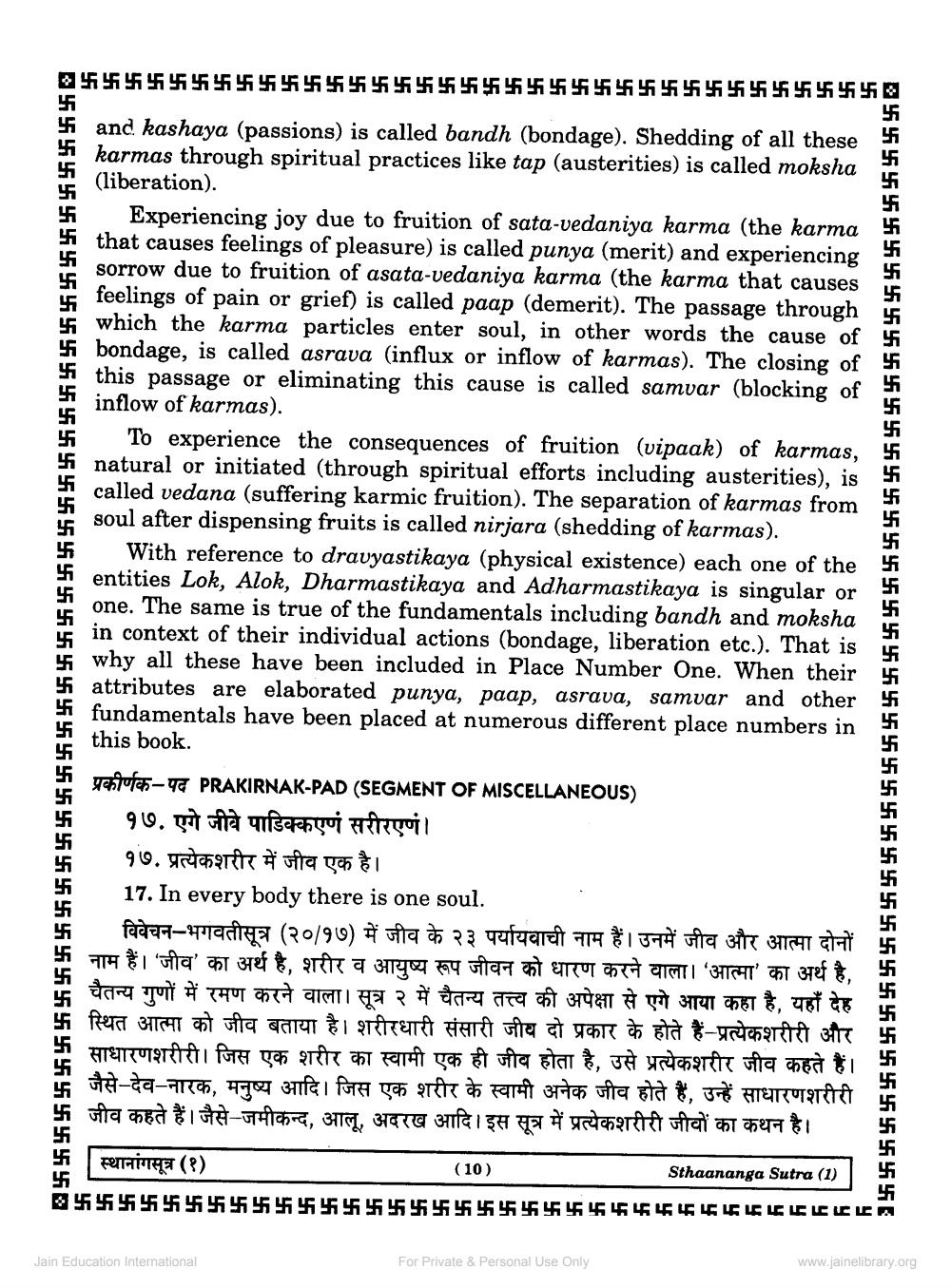________________
B555555555555555555555555555555555
))))5555
)))5555))
and. kashaya (passions) is called bandh (bondage). Shedding of all these karmas through spiritual practices like tap (austerities) is called moksha
(liberation). $i Experiencing joy due to fruition of sata-vedaniya karma (the karma i that causes feelings of pleasure) is called punya (merit) and experiencing
sorrow due to fruition of asata-vedaniya karma (the karma that causes
feelings of pain or grief) is called paap (demerit). The passage through 4 which the karma particles enter soul, in other words the cause of
bondage, is called asrava (influx or inflow of karmas). The closing of this passage or eliminating this cause is called samvar (blocking of inflow of karmas).
To experience the consequences of fruition (vipaak) of karmas, natural or initiated (through spiritual efforts including austerities), is called vedana (suffering karmic fruition). The separation of karmas from
soul after dispensing fruits is called nirjara (shedding of karmas). 4 With reference to dravyastikaya (physical existence) each one of the 4 entities Lok, Alok, Dharmastikaya and Adharmastikaya is singular or
one. The same is true of the fundamentals including bandh and moksha in context of their individual actions (bondage, liberation etc.). That is
why all these have been included in Place Number One. When their i attributes are elaborated punya, paap, asrava, samvar and other
fundamentals have been placed at numerous different place numbers in this book. प्रकीर्णक-पद PRAKIRNAR-PAD (SEGMENT OF MISCELLANEOUS)
१७. एगे जीवे पाडिक्कएणं सरीरएणं। १७. प्रत्येकशरीर में जीव एक है। 17. In every body there is one soul.
विवेचन-भगवतीसूत्र (२०/१७) में जीव के २३ पर्यायवाची नाम हैं। उनमें जीव और आत्मा दोनों नाम हैं। 'जीव' का अर्थ है, शरीर व आयुष्य रूप जीवन को धारण करने वाला। 'आत्मा' का अर्थ है,
चैतन्य गुणों में रमण करने वाला। सूत्र २ में चैतन्य तत्त्व की अपेक्षा से एगे आया कहा है, यहाँ देह ॐ स्थित आत्मा को जीव बताया है। शरीरधारी संसारी जीय दो प्रकार के होते हैं-प्रत्येकशरीरी और
साधारणशरीरी। जिस एक शरीर का स्वामी एक ही जीव होता है, उसे प्रत्येकशरीर जीव कहते हैं।
जैसे-देव-नारक, मनुष्य आदि। जिस एक शरीर के स्वामी अनेक जीव होते हैं, उन्हें साधारणशरीरी 卐 जीव कहते हैं। जैसे-जमीकन्द, आलू, अदरख आदि। इस सूत्र में प्रत्येकशरीरी जीवों का कथन है।
)))))))))))))
卐))
| स्थानांगसूत्र (१)
(10)
Sthaananga Sutra (1)
马步步步步步步步步步步步步步步步步男男男男男男男%%%%%%%ELLELEA
Jain Education International
For Private & Personal Use Only
www.jainelibrary.org




